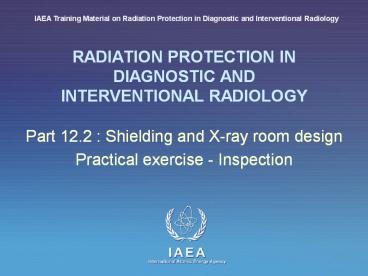RADIATION PROTECTION IN DIAGNOSTIC AND INTERVENTIONAL RADIOLOGY - PowerPoint PPT Presentation
1 / 23
Title:
RADIATION PROTECTION IN DIAGNOSTIC AND INTERVENTIONAL RADIOLOGY
Description:
X-ray rooms : must be large enough for the equipment ... Image intensifier. X-ray tube. IAEA. 12.2 : Shielding and X-ray room design. 21. CT Room Entrance ... – PowerPoint PPT presentation
Number of Views:883
Avg rating:3.0/5.0
Title: RADIATION PROTECTION IN DIAGNOSTIC AND INTERVENTIONAL RADIOLOGY
1
RADIATION PROTECTION INDIAGNOSTIC
ANDINTERVENTIONAL RADIOLOGY
IAEA Training Material on Radiation Protection in
Diagnostic and Interventional Radiology
- Part 12.2 Shielding and X-ray room design
- Practical exercise - Inspection
2
Overview / Objectives
- Subject matter Inspection of diagnostic
radiology department - Step by step procedure to be followed
- Interpretation of results
3
Part 12.2 Shielding and X-ray room design
IAEA Training Material on Radiation Protection in
Diagnostic and Interventional Radiology
- Practical exercise -
- Check list inspection of diagnostic radiology
department
4
Radiology Department Features
- Physical
- Access, and access restriction
- Separation of work and public areas
- Radiation signs (trefoils, illuminated signs)
- Shielding construction and materials
- Protective equipment
- Operational
- QC program
- Local rules
- Staff qualifications and training
5
Radiology Department Infrastructure
- This must include
- electrical power
- air conditioning and/or ventilation
- floor space and floor loading
- links to other critical areas e.g.. emergency
6
Design Principles (1)
- For a safe radiation environment, there are
certain principles and considerations - separation of different functional areas helps
control access - public areas (waiting, change etc.)
- staff areas (offices, meeting rooms etc.)
- work areas (radiation rooms, dark rooms, labs.)
7
Patient Access Corridor
- Note
- room numbers
- access to change rooms
- no access to staff areas
8
Controlled Areas
9
Design Principles (2)
- Restriction/control of public access to work
areas - work areas will normally be controlled areas,
therefore public can only access when being
examined or treated - Flow of staff to/from and within work areas -
separate from public areas
10
Design Principles (3)
- Consideration of spaces adjacent to radiation
areas, including above and below - Storage space required (always more than
anticipated!!) - Lab./teaching/meeting areas
11
Design Principles (4)
- Film processing/storage
- location relative to radiation areas
- chemical storage and disposal
- ventilation (glutaraldehyde fumes)
- silver recovery
- bulk film storage
12
Categories of Radiology Departments
- WHO (1988) has three categories
- general radiography, general ultrasound, general
fluoroscopy, conventional tomography - as Level 1, plus Doppler ultrasound, mammography,
angiography (incl. DSA), CT - as Level 2, with more sophisticated techniques,
plus MRI
13
Radiology Room Features
- X-ray tube(s) and table
- Chest stand
- Change room(s)
- Operators console
- Darkroom and film storage
- Surrounding areas (use, occupancy)
- Shielding
14
Typical Room Design
15
Department Design (1)
- Larger departments, with 4 or more rooms can be
arranged to have separated traffic flows, but
small departments can do this by having separate
entry for staff and patients
16
Department Design (2)
- X-ray rooms
- must be large enough for the equipment (remember
a chest stand) - should have at least one patient change cubicle
accessible from outside the room - must locate the operators console where the
primary beam will NEVER be directed towards it,
but where the patient can be easily observed
17
Fluoroscopy Room Operators Area
Note Lead glass, clear view, good lighting
18
Fluoroscopy Room
19
Department Design (3)
- must be able to accommodate large beds/trolleys,
and any anaesthetic equipment likely to be used - must locate holes in floors for cables away from
radiation beams, or be shielded - must have radiation warning signs on all doors
- should have radiation warning lights outside for
fluoroscopy, angiography and CT
20
C-Arm Fluoroscopy UnitNote Image
intensifier X-ray tube
21
CT Room Entrance Note illuminated warning
sign sliding shielded doors radiation warning
sign
22
Protective Equipment
- Basically lead vinyl materials, especially gowns
- Lead vinyl is 0.3 - 0.5 mm equivalent
- Front is more important than rear
- Can be partially open at rear (only high Pb)
- Must be tested new and every 18 months (using
fluoroscopy)
23
Radiology Work Area
- Note
- rack for lead gowns,
- and easy access to
- all work rooms for
- staff































